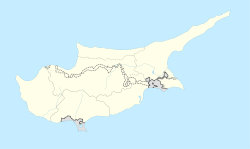Kykkos
| Κύκκος | |

Kykkos Monastery
|
|
| Monastery information | |
|---|---|
| Full name | The Holy, Royal and Stavropegic Monastery of Kykkos |
| Order | Orthodox monasticism |
| Established | 11th century |
| Dedicated to | Virgin Mary |
| Celebration date | August 15, September 8 |
| Diocese | Church of Cyprus |
| Controlled churches | Metochi Kykkou |
| People | |
| Founder(s) | Alexios I Komnenos |
| Prior | Nikiphoros, Metropolitan of Kykkos and Tylliria |
| Architecture | |
| Style | Byzantine |
| Site | |
| Location | Troodos, Paphos District |
| Country | Cyprus |
| Coordinates | 34°59′02″N 32°44′28″E / 34.984°N 32.741°ECoordinates: 34°59′02″N 32°44′28″E / 34.984°N 32.741°E |
Kykkos Monastery (Greek: Ιερά Μονή Κύκκου or Κύκκος [locally [ˈt͡ʃikʰos]] for short, Turkish: Cikko Manastırı), which lies 20 km west of Pedoulas, is one of the wealthiest and best-known monasteries in Cyprus.
The Holy Monastery of the Virgin of Kykkos was founded around the end of the 11th century by the Byzantine emperor Alexios I Komnenos (1081–1118). The monastery lies at an altitude of 1318 meters on the north west face of Troödos Mountains. There are no remains of the original monastery as it was burned down many times. The first President of Cyprus, Archbishop Makarios III started his ecclesiastical career there as a monk in 1926. He remained fond of the place and returned there many times. His request to be buried there materialised after his death in 1977. His tomb lies 3 km west of Kykkos monastery and remains a popular visitor destination.
According to tradition, a virtuous hermit called Esaias was living in a cave on the mountain of Kykkos. One day, the Byzantine governor of the island, doux Manuel Boutoumites, who was spending the summer at a village of Marathasa because of the heat of the season, went into the forest to hunt. Having lost his way in the forest he met Monk Esaias and asked him to show him the way. The hermit who was not interested in the things of this world would not answer his questions.
Boutoumites got angry at the monk's indifference and called him names and even maltreated him. Not long after, when the doux returned to Nicosia, he fell ill with an incurable illness by the name of lethargia. In his terrible condition he remembered how inhumanly he had treated the hermit Esaias and asked God to cure him so that he might go to ask the hermit personally for forgiveness. And this came to pass. But God had appeared in front of the hermit and revealed to him that the very thing that had happened had been planned by the divine will and advised him to ask Boutoumites to bring the icon of the Virgin, that had been painted by the Apostle Luke, to Cyprus.
...
Wikipedia

